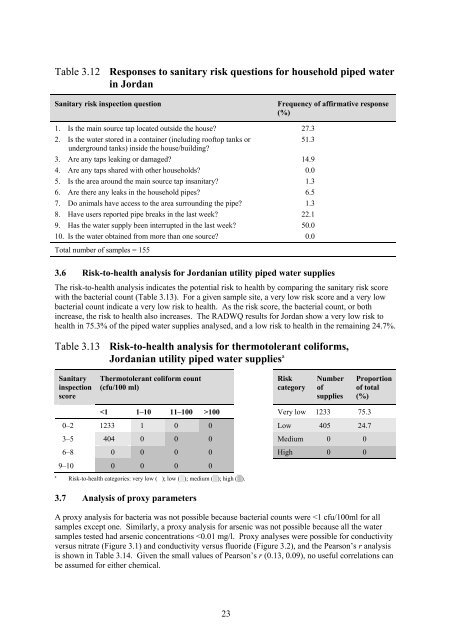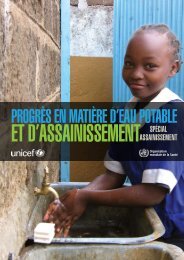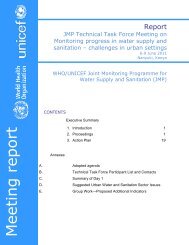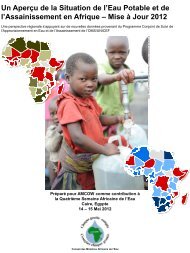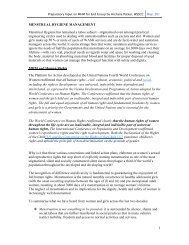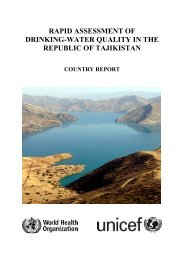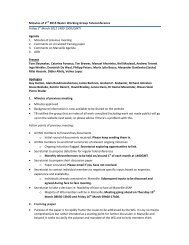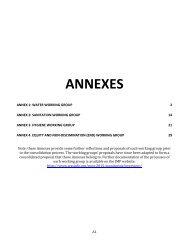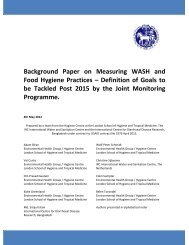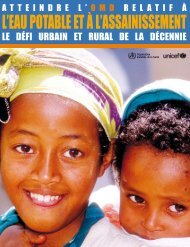Rapid assessment of drinking-water quality in the - WHO/UNICEF ...
Rapid assessment of drinking-water quality in the - WHO/UNICEF ...
Rapid assessment of drinking-water quality in the - WHO/UNICEF ...
You also want an ePaper? Increase the reach of your titles
YUMPU automatically turns print PDFs into web optimized ePapers that Google loves.
Table 3.12 Responses to sanitary risk questions for household piped <strong>water</strong><br />
<strong>in</strong> Jordan<br />
Sanitary risk <strong>in</strong>spection question<br />
Frequency <strong>of</strong> affirmative response<br />
(%)<br />
1. Is <strong>the</strong> ma<strong>in</strong> source tap located outside <strong>the</strong> house 27.3<br />
2. Is <strong>the</strong> <strong>water</strong> stored <strong>in</strong> a conta<strong>in</strong>er (<strong>in</strong>clud<strong>in</strong>g ro<strong>of</strong>top tanks or<br />
51.3<br />
underground tanks) <strong>in</strong>side <strong>the</strong> house/build<strong>in</strong>g<br />
3. Are any taps leak<strong>in</strong>g or damaged 14.9<br />
4. Are any taps shared with o<strong>the</strong>r households 0.0<br />
5. Is <strong>the</strong> area around <strong>the</strong> ma<strong>in</strong> source tap <strong>in</strong>sanitary 1.3<br />
6. Are <strong>the</strong>re any leaks <strong>in</strong> <strong>the</strong> household pipes 6.5<br />
7. Do animals have access to <strong>the</strong> area surround<strong>in</strong>g <strong>the</strong> pipe 1.3<br />
8. Have users reported pipe breaks <strong>in</strong> <strong>the</strong> last week 22.1<br />
9. Has <strong>the</strong> <strong>water</strong> supply been <strong>in</strong>terrupted <strong>in</strong> <strong>the</strong> last week 50.0<br />
10. Is <strong>the</strong> <strong>water</strong> obta<strong>in</strong>ed from more than one source 0.0<br />
Total number <strong>of</strong> samples = 155<br />
3.6 Risk-to-health analysis for Jordanian utility piped <strong>water</strong> supplies<br />
The risk-to-health analysis <strong>in</strong>dicates <strong>the</strong> potential risk to health by compar<strong>in</strong>g <strong>the</strong> sanitary risk score<br />
with <strong>the</strong> bacterial count (Table 3.13). For a given sample site, a very low risk score and a very low<br />
bacterial count <strong>in</strong>dicate a very low risk to health. As <strong>the</strong> risk score, <strong>the</strong> bacterial count, or both<br />
<strong>in</strong>crease, <strong>the</strong> risk to health also <strong>in</strong>creases. The RADWQ results for Jordan show a very low risk to<br />
health <strong>in</strong> 75.3% <strong>of</strong> <strong>the</strong> piped <strong>water</strong> supplies analysed, and a low risk to health <strong>in</strong> <strong>the</strong> rema<strong>in</strong><strong>in</strong>g 24.7%.<br />
Table 3.13 Risk-to-health analysis for <strong>the</strong>rmotolerant coliforms,<br />
Jordanian utility piped <strong>water</strong> supplies a<br />
Sanitary<br />
<strong>in</strong>spection<br />
score<br />
Thermotolerant coliform count<br />
(cfu/100 ml)<br />
Risk<br />
category<br />
Number<br />
<strong>of</strong><br />
supplies<br />
Proportion<br />
<strong>of</strong> total<br />
(%)<br />
100 Very low 1233 75.3<br />
0–2 1233 1 0 0 Low 405 24.7<br />
3–5 404 0 0 0 Medium 0 0<br />
6–8 0 0 0 0 High 0 0<br />
9–10 0 0 0 0<br />
a<br />
Risk-to-health categories: very low ( ); low ( ); medium ( ); high ( ).<br />
3.7 Analysis <strong>of</strong> proxy parameters<br />
A proxy analysis for bacteria was not possible because bacterial counts were


